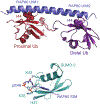Molecular Basis for K63-Linked Ubiquitination Processes in Double-Strand DNA Break Repair: A Focus on Kinetics and Dynamics
- PMID: 28587922
- PMCID: PMC7507754
- DOI: 10.1016/j.jmb.2017.05.029
Molecular Basis for K63-Linked Ubiquitination Processes in Double-Strand DNA Break Repair: A Focus on Kinetics and Dynamics
Abstract
Cells are exposed to thousands of DNA damage events on a daily basis. This damage must be repaired to preserve genetic information and prevent development of disease. The most deleterious damage is a double-strand break (DSB), which is detected and repaired by mechanisms known as non-homologous end-joining (NHEJ) and homologous recombination (HR), which are components of the DNA damage response system. NHEJ is an error-prone first line of defense, whereas HR invokes error-free repair and is the focus of this review. The functions of the protein components of HR-driven DNA repair are regulated by the coordinated action of post-translational modifications including lysine acetylation, phosphorylation, ubiquitination, and SUMOylation. The latter two mechanisms are fundamental for recognition of DSBs and reorganizing chromatin to facilitate repair. We focus on the structures and molecular mechanisms for the protein components underlying synthesis, recognition, and cleavage of K63-linked ubiquitin chains, which are abundant at damage sites and obligatory for DSB repair. The forward flux of the K63-linked ubiquitination cascade is driven by the combined activity of E1 enzyme, the heterodimeric E2 Mms2-Ubc13, and its cognate E3 ligases RNF8 and RNF168, which is balanced through the binding and cleavage of chains by the deubiquitinase BRCC36, and the proteasome, and through the binding of chains by recognition modules on repair proteins such as RAP80. We highlight a number of aspects regarding our current understanding for the role of kinetics and dynamics in determining the function of the enzymes and chain recognition modules that drive K63 ubiquitination.
Keywords: DNA damage response; enzyme kinetics; protein dynamics; protein–protein-interactions; ubiquitination.
Copyright © 2017 Elsevier Ltd. All rights reserved.
Figures




Similar articles
-
Histone H1 couples initiation and amplification of ubiquitin signalling after DNA damage.Nature. 2015 Nov 19;527(7578):389-93. doi: 10.1038/nature15401. Epub 2015 Oct 21. Nature. 2015. PMID: 26503038
-
Rad18 and Rnf8 facilitate homologous recombination by two distinct mechanisms, promoting Rad51 focus formation and suppressing the toxic effect of nonhomologous end joining.Oncogene. 2015 Aug 13;34(33):4403-11. doi: 10.1038/onc.2014.371. Epub 2014 Nov 24. Oncogene. 2015. PMID: 25417706
-
Role of deubiquitinating enzymes in DNA double-strand break repair.J Zhejiang Univ Sci B. 2021 Jan 15;22(1):63-72. doi: 10.1631/jzus.B2000309. J Zhejiang Univ Sci B. 2021. PMID: 33448188 Free PMC article. Review.
-
The Rap80-BRCC36 de-ubiquitinating enzyme complex antagonizes RNF8-Ubc13-dependent ubiquitination events at DNA double strand breaks.Proc Natl Acad Sci U S A. 2009 Mar 3;106(9):3166-71. doi: 10.1073/pnas.0807485106. Epub 2009 Feb 6. Proc Natl Acad Sci U S A. 2009. PMID: 19202061 Free PMC article.
-
Regulation of repair pathway choice at two-ended DNA double-strand breaks.Mutat Res. 2017 Oct;803-805:51-55. doi: 10.1016/j.mrfmmm.2017.07.011. Epub 2017 Jul 29. Mutat Res. 2017. PMID: 28781144 Review.
Cited by
-
USP15: a review of its implication in immune and inflammatory processes and tumor progression.Genes Immun. 2021 May;22(1):12-23. doi: 10.1038/s41435-021-00125-9. Epub 2021 Apr 6. Genes Immun. 2021. PMID: 33824497 Review.
-
Sex-Specific Linear Polyubiquitination Is a Critical Regulator of Contextual Fear Memory Formation.Front Behav Neurosci. 2021 Jul 9;15:709392. doi: 10.3389/fnbeh.2021.709392. eCollection 2021. Front Behav Neurosci. 2021. PMID: 34305548 Free PMC article.
-
Cypin regulates K63-linked polyubiquitination to shape synaptic content.Sci Adv. 2025 Jul 11;11(28):eads5467. doi: 10.1126/sciadv.ads5467. Epub 2025 Jul 11. Sci Adv. 2025. PMID: 40644549 Free PMC article.
-
Emerging Roles of Non-proteolytic Ubiquitination in Tumorigenesis.Front Cell Dev Biol. 2022 Jul 6;10:944460. doi: 10.3389/fcell.2022.944460. eCollection 2022. Front Cell Dev Biol. 2022. PMID: 35874839 Free PMC article. Review.
-
Breaking the chains: deubiquitylating enzyme specificity begets function.Nat Rev Mol Cell Biol. 2019 Jun;20(6):338-352. doi: 10.1038/s41580-019-0099-1. Nat Rev Mol Cell Biol. 2019. PMID: 30733604 Review.
References
Publication types
MeSH terms
Substances
Grants and funding
LinkOut - more resources
Full Text Sources
Other Literature Sources
Research Materials

